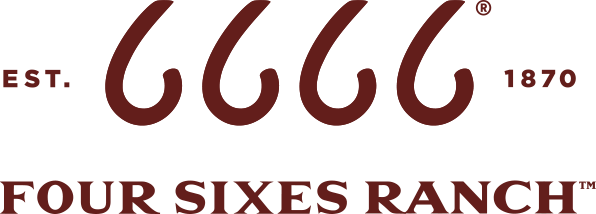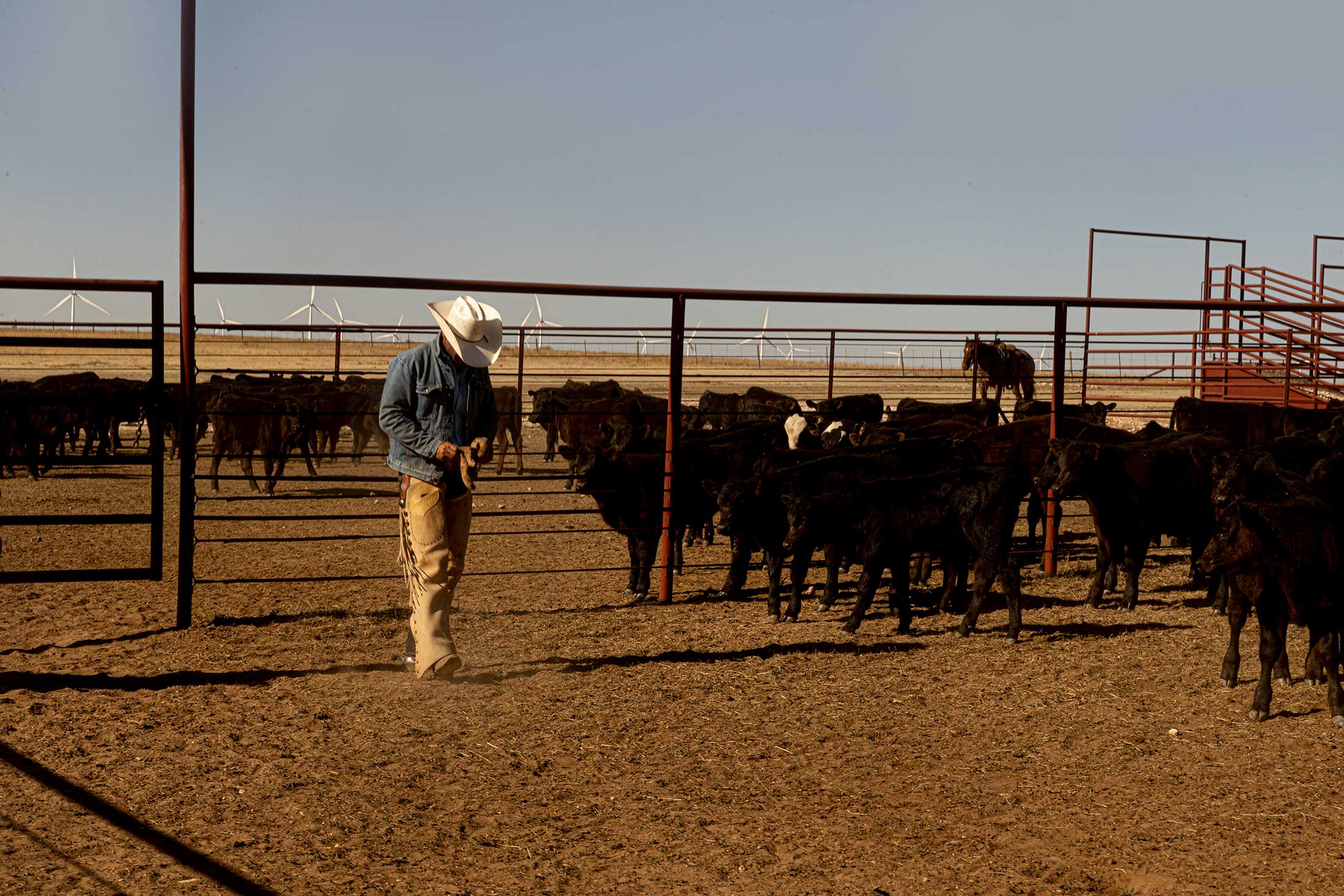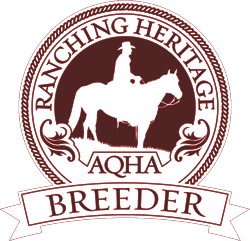Few ranches in America represent the past and present like the 6666.
American Cowboy, story by Julie Mankin published Feb 13, 2017
Photo by Emerson Miller
In 1868, an eager young cowboy named Samuel “Burk” Burnett joined an outfit that was headed up the Chisholm Trail to Abilene, Kan. The following year, then 20 years old, Burnett drove up another herd of 1,200 head, this one belonging to his father, a Confederate Army captain named Jerry Burnett. Indians raided his remuda along the way, but the young Burnett was not deterred and, showing his fierce will, helped deliver those cattle to market. Impressed, his father promoted him from cowboy to partner. Legend has it that Burnett, the oldest of 10 siblings, later won the first parcels of his now-famous ranch in a poker game with a hand of straight sixes. But according to the man himself, he purchased 100 head of cattle from Frank Crowley in 1871, and the animals already wore the 6666 brand. Hoping to deter would-be rustlers, he also bought the brand, because it was difficult to alter. The rest, well, is history.
Without men like Burnett and the ranches they founded, there would be no singing cowboys, no cattlemen, and no rodeo stars. And few ranches in America represent the past and present like the 275,000-acre holdings headquartered by the 6666 in Guthrie, Texas. The Texas cattle empire has survived since 1871 not just because of black gold (plenty of historic ranches had oil), but because of the keen foresight of founder Burk Burnett and the stoic leadership of his granddaughters.
There were plenty of Spanish ranchos in California by the 19th century, but ranching as we know it in America has its roots in Texas. Bands of long-horned bovines were first tended here by Spanish missionaries on the San Antonio River in 1749. And the wild, feral descendants of those original longhorns, along with others left to roam free during the Civil War, were the rest animals driven north by Texans to better markets.
Burnett was cunning enough to survive the “Panic of 1873”—a sudden drop in silver prices that broke railroad companies and caused a six-year depression—by simply holding over the 1,100 steers he had driven to Wichita, Kan., the year before. He was the first cattleman to think of this, and it netted him $10,000, which he used to buy 1,300 more head of cattle in south Texas and a new 17,000-acre ranch along the Red River near present-day Wichita Falls. A master of squeezing big returns from small investments, Burnett grew richer by the minute until he was a bona de cattle baron.
During the drought of 1881, the grass was withering away and starving his cattle, so Burnett leased 280,000 acres of Kiowa and Comanche land across the river for 6.5 cents an acre. His contact there was with the famous Quanah Parker, last chief of the free Comanches. In subsequent years, the two developed a deep respect and admiration. Burnett was known to have slept on the wraparound porch of Quanah’s house and was given special gifts, like a chief’s war lance. He was even called Mas-Sa-Suta, or “Big Boss,” by the Comanche people.
In 1898, the federal government wanted the cowboys off Indian lands to open them for homesteading. But Burnett would not let his investment go to waste. He traveled to Washington and lobbied President Theodore Roosevelt to give the ranchers two more years. Roosevelt granted the extension, and to thank him, Burnett and the others invited the newly inaugurated President to Texas in the spring of 1905 for a “barehanded” wolf hunt. For 10 days, the aging Quanah taught Roosevelt how to track horse thieves while Burnett and other ranchers led the hunt. Roosevelt’s party bagged 17 wolves and coyotes, and he killed a five-foot rattlesnake with his quirt. Lifelong friendships were forged. Years later, the President visited the 6666 and convinced one north Texas community to re-name their town “Burkburnett” after his old friend.
Burnett had seen the limiting effects of barbed wire on the open range, so in 1893 he began looking West to expand the 6666. He bought the Eight Ranch and its 15,000 head of cattle in the Texas panhandle from the Louisville Land and Cattle Company, which had owned the property since 1883. When the deal was finalized in 1900, Burnett paid $550,000 (mostly in cash), and the hefty sale was reported by the New York Times. Two years later, Burnett paid $2.65 an acre for 108,000 acres to the north, along Dixon Creek. All together, the new location of the 6666 totaled 206,000 acres of rolling hills.
Burnett was known for his meticulously tidy ranch headquarters, but he also kept a home in Fort Worth for decades and made frequent trips to his ranches in his 1894 custom-designed Pullman railcar. (For the last 30 miles or so to Guthrie, he’d hitch a horse and buggy and drive the rest of the way.) He eventually acquired oil company interests and was a stockholder in the First National Bank of Fort Worth, which had been founded by his father-in-law, Martin Loyd.
Burnett was married three times, first at 20 years old to Ruth Loyd, with whom he had a son, Thomas Loyd in 1871, and daughter Anne Valliant. After divorcing Ruth in 1892, the 43-year-old Burnett married a young widow named Mary Barradel. The couple had another son, Burk Burnett Jr. Meanwhile, Burnett’s oldest son, Tom, grew up line riding on his father’s ranch and tending cattle across the river on the Indians’ half-million-acre “Big Pasture.” He became a fine cowboy, forming lifelong friendships with the Comanches, whose language he spoke well.
In 1891, 20-year-old Tom made wagon boss on the “Nation” wagon (so called because it was used for roundups on Indian lands) and married Ollie Lake. Their daughter was named Anne, after Tom’s sister. But he divorced Ollie in 1918 and had a string of other short, unsuccessful marriages, which offended his father. Old Burnett was already having a rough time: His beloved daughter Annie had died young in 1914 and, less than two years later, he’d buried his young son, 21-year-old Burk Jr. So when he died in 1922, he did not leave the “Four Sixes” to Tom but to the “future firstborn child” of his granddaughter, the 22-year-old “Miss Anne.”
Later, Miss Anne herself inherited a half-million acres, thousands of Herefords, and oil interests from Tom, who had spent his life trying to match his father’s fortune. At one point, Miss Anne was one of the richest ranchers in Texas. She also inherited her grandfather’s strong will and ably managed the 6666 until passing it to her daughter, Little Anne, born in 1939.
And thanks to Miss Anne, the 6666 started the tradition of branding its horses with her maternal great-grandfather Martin Loyd’s single L brand. Miss Anne and George Humphreys, her 6666 foreman from 1932 to1970, set out to raise standout equine athletes on the ranch and spearheaded the famous careers of stallions Grey Badger II and Hollywood Gold. Together with her second husband, James Goodwin Hall, Miss Anne helped form the American Quarter Horse Association in 1940. The first female member of the Fort Worth Chamber of Commerce, she also founded the $200 million Burnett Foundation in 1978. Upon Miss Anne’s death in 1980, then-41-year-old Little Anne took the reins of the 6666.
Now 77 and married to Sotheby’s magnate John Marion, “Little” Anne Marion continues her mother’s support of museums, fine art, and ranching heritage. She’s busy as president or chair of the Burnett Foundation, Burnett Companies, and Burnett Oil Company, Inc.
“But the ranch is far and away the business I’m involved most closely with,” says Marion. “It’s literally part of my heritage—I used to spend as much time as possible there in my early years, so I really learned ranching from the ground up.”
Marion and her first husband, renowned breeder B.F. Phillips Jr., put the 6666 on the map in Quarter Horse racing. A bronze of their immortal 1980s-era stallion, Dash For Cash, still graces the “Sixes’” equine division headquarters. And nestled in the trees on a rise overlooking the ranch entrance, the magnificent $100,000 stone house that Burk Burnett built in 1917 stands sentinel. (Although he kept a bedroom in the home, Burnett often chose to sleep in the back room of the rudimentary 6666 Supply House.) The house is surrounded by 18 acres of outbuildings, including the famous 6666 Supply House, which remains the only store in Guthrie.
“You can buy anything there, from tires to groceries to clothing,” says Joe Leathers, general manager of the 6666. “They sell gas there, too, because it’s 30 miles to the nearest gas station and an hour and a half to a town.”
This land, 100 dusty miles from both Lubbock and Wichita Falls, is shockingly isolated even today and must have seemed very remote indeed to first owner Sam Lazarus in 1880.
The town of Guthrie is actually ranch headquarters. Named for Louisville Land and Cattle stockholder W.H. Guthrie, the community had 100 residents at the turn of the 20th century, most of them cowboys punching for the 6666 and neighboring Pitchfork Ranch. More than 100 years later, Guthrie’s population has only grown to 160. And many things remain the same, like that stately 11-bedroom stone house, where Marion stays (and the foreman lives in a wing with his family) and Burnett hosted Roosevelt, Will Rogers, and other friends.
The 6666 has had just six managers since 1883, when it was still the Eight Ranch. In fact, Burnett’s first manager, Bud Arnett, had already served as foreman of the Eight for 17 years and knew every sagebrush and anthill on the ranch. Arnett retired from the 6666 in 1930 after three decades on the job, and was succeeded by George Humphreys and J.J. Gibson Jr., the sons of other Eight Ranch hands. Humphreys guided the 6666 through the Great Depression, developed the horse operation, and retired in 1970 after 52 years on the ranch. Gibson took over for 21 years and handed the reins to son Mike in 1991, who was foreman for another 17 years. Current foreman Joe Leathers took over in 2008. The 6666 inspires some kind of loyalty.
In terms of livestock, the 6666 raised purebred Hereford pairs until 1970, when Brangus cattle were introduced. Then in 1996, the massive herd of 7,000 was slowly switched over to black Angus, a breed of cattle that many agree provides higher quality meat and is easier to handle and market.
Between checking windmills and fences and pregnant heifers, roping calves in the branding pen, and sorting cattle, cowboy work here requires 17 to 18 full-time hands.
“We do every bit of work that can be done horseback on horses,” says Leathers. “We do a lot of herd work, holding them up and handling them.”
The cows calve in the fall, and the cowboys spend six weeks branding around Thanksgiving and Christmas, then wean in June. In 1982, Anne Marion hired veterinarian Glenn Blodgett to head up the ranch’s horse-breeding program. A decade later, their reproduction program was state-of-the-art and their ranch horses so renowned that they began running the facility as a public clinic and marketing their horses.
“We halter-break 200 foals each year,” says Blodgett. “That’s a lot of horses, and we usually use donkeys to teach them to lead.” The older colts are broke each winter, and every cowboy has his own “mount” of eight to 10 horses that nobody else rides. The older, solid cowponies are sold as the younger colts come up, while some aces are kept for kids’ horses. Every cowboy (and his family, too, if he has one) lives on the spread, which today totals 275,000 acres. The hands eat breakfast and dinner together at headquarters. Miles from the main quarters at Guthrie, four different camps are spread across the ranch, where barns, corrals, and houses have replaced the original chuck wagons.
The two 6666 bunkhouses have plenty of history and then some. Their most famous resident is probably Boots O’Neal, who at 84 has been punching cows for well over 50 years. In addition to working at the famous JA and Matador ranches, O’Neal broke broncs on the Waggoner Ranch for 24 years, where for a decade he was foreman with some 40 cowboys under him.
“I haven’t been here a long time, considering my age,” quips O’Neal about his 26 years on the Sixes. Although he could retire and live a life of leisure, this ol’ cowboy still rides the range every day. Starting before dawn, he saddles whatever young horse he’s working with and spends the day checking cattle, or “prowling” one of the pastures, which each average about 7,000 acres. His favorite tasks, though, are roping horses out of the remuda and cutting out the “dry” (unbred) cows from a herd.
Looking back on more than two decades at the Sixes, O’Neal rates it as the best years of his life. “I like the way they work livestock, and I like their management,” says O’Neal. A true throwback, he has a special license to pack heat anywhere in Texas and has battled outlaws as a Texas Ranger and busted rustlers as a brand inspector. He’s also deputy sheriff of King County.
On the cattle end, commercial sales of bred heifers are flourishing thanks to a massive brush-clearing movement that has the ranch producing 10 more cows per acre than ever before.
“I want the American public to realize they influence our decisions, because they are a part of this ranch,” says Leathers. “They are a part of the ranching industry as a whole, because they have a valuable stake in it.”
As for Blodgett, his equine program continues to produce racing world champions as well as prized working cow horses, which earned the ranch the AQHA’s Best Remuda Award in 1994. The success is partly due to the veterinarian’s time as a working cowboy.
“The first 15 years I was here, I spent a lot of time horseback,” he says. “I’d go when they gathered the pastures, and I got a real appreciation for what’s required of a horse working day after day over a long period of time.”
If the mark of a good leader is surrounding oneself with outstanding individuals, then Anne Marion has proved to be a shrewd observer of character.
“Anne loves this ranch and loves the people who work for her,” says Leathers. “She gives Dr. Blodgett and me the opportunity to be visionaries and try different things, and she’s willing to back us. That’s one thing that’s made this ranch so unique—she’s so easy to visit with and lets us try things a lot of ranch managers can’t try.”
Her husband, John Marion, lauds her other qualities, too: “It’s fascinating to see her in the boardroom talking about oil and cattle. But she has another side, too. She’s a very astute art collector. Very cultured. Very refined.”
In 2009, Marion was inducted into the National Cowboy & Western Heritage Museum’s Hall of Great Westerners, joining her great-grandfather, grandfather, and mother.
“The most important thing that ever happened to me was growing up on that ranch,” says Marion. “It has kept my feet on the ground.” And it would surely please Burk Burnett to know that the family legacy of strong-willed, keenly intelligent Annes continues—Marion’s daughter Anne “Windi” Grimes has a daughter named Anne “Hallie” Grimes.
Let’s be frank: Anne Marion doesn’t need cattle or horses or cowboys to help pay the bills at this point. But she keeps at it from the heart. “We want to do most things today in the same way as a century ago,” says Marion. “That is to say, cattle are handled horseback; we have no four-wheelers or helicopters. All in all, we work hard to maintain the tradition and quality of the rancher’s life.”
After more than 140 years, Sixes hands still saddle up and wait on daylight to corral, gather, brand, and sort cattle and herds of horses. And that’s the reason men like Joe Leathers and Boots O’Neal live and work here.
“When I top out over a ridge and see a large herd of cattle, I think how blessed I am to be able to see what my forefathers saw,” says Leathers. “For an instant, I get a picture of what these prairies were like covered with buffalo—what the Indians saw. I wish everyone in the United States could experience that.” Some people never want anything but to be cowboys for their entire lives.
At a spread like this, that’s enough.












